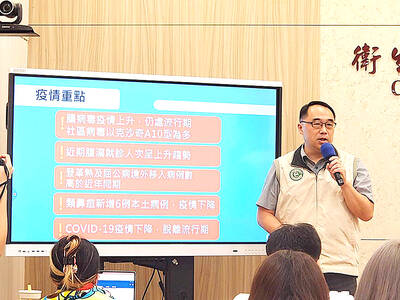Taipei Times: It is widely believed that China's People's Liberation Army Navy (PLAN) has been making substantial progress, particularly with their submarine force. What is your evaluation of PLAN?
Rear Admiral Sumihiko Kawamura: I see PLAN's capability as still being limited or weak in terms of the four major missions of a navy -- strategic deterrence, projection of power, sea control and sea-lane security. Let me analyze those items.
PLAN may have strategic deterrence ability. Their nuclear submarines may be able to launch intercontinental ballistic missiles [ICBMs] at locations close to their shores under their air force and navy's protection, but ICBMs are their only reliable weapons.
Regarding PLAN's ability to project power, its range only extends to the waters around Taiwan. PLAN's submarines have a very limited ability to prevent the US and Japanese navies from projecting their power to the waters around Taiwan.
As for its ability to control sea lanes, it would be impossible for PLAN to control the waters between China and Taiwan if it faced a US and Japanese joint naval force. In contrast, within the so-called first island chain [islands including the Aleutians, Japan, South Korea, Okinawa, Taiwan, the Philippines and Singapore], PLAN has a very limited capability to deny the US and Japan command of the seas.
So if China invaded Taiwan, PLAN would not be able to sustain logistic support from China because it cannot control the waters between Taiwan and China.
Finally, China also has a limited capability to conduct a blockade of sea lanes.
TT: So you don't have a high opinion of PLAN's submarine force?
Kawamura: China has about 70 submarines. Most of China's submarines are conventional submarines, which need to come up to surface about every four to seven days. So those submarines are easy to detect any time they surface. In addition, conventional submarines are difficult to operate in the ocean. That means PLAN's submarines have a limited ability to confront US forces in the Pacific Ocean.
TT: Are their more advanced submarines such as the Kilo Class submarines so easy to detect?
Kawamura: It is easy. Kilos are not cutting-edge submarines. In the past, the US and Japan easily tracked Russia's submarines, and in comparison, the Russian submarines were quicker than China's.
If the US and Japan jointly go to war with China, I am afraid China's submarine fleet would be unable to survive for more than one week after a conflict broke out, and it would be a one-sided game
TT: It is widely believed that China is operating undersea surveys in waters south and north of Taiwan to find an effective way to block the US navy in the event of military conflict in the Taiwan Strait. Would PLAN succeed?
Kawamura: It would not succeed. The US and Japan would be able to operate against their submarines from the air. While the US has 80 P-3C maritime-patrol aircraft stationed in Japan, Japan also owns over 120 P-3Cs. Our P-3C force would be able to detect and destroy Chinese submarines in waters to the south and north of Taiwan before the US fleet entered waters close to Taiwan. So their scheme would not succeed.
TT: The US has approved the sale of 12 P-3C aircraft, three PAC-3 anti-missile batteries and eight diesel-power submarines to Taiwan, but the arms bill has been stalled in the legislature. Among those items, which should be the priority for Taiwan? Do you agree with some who say that Taiwan's military should put the submarines at the top of the list?
Kawamura: P-3Cs and acquiring better C4ISR [command, communications, coordination, computers, intelligence, surveillance and reconnaissance] are priorities for Taiwan's military.
Currently, what is most important for the country is knowing how to bring about interoperability between Taiwan, Japan and the US' military. A Taiwanese P-3C force with the better 4CISR systems the aircraft has would be used in conjunction with those of the US and Japan, and the connection would largely strengthen US-Japan-Taiwan military cooperation.
Significantly, if the three countries share more 4CISR information, the US and even Japan would have a better chance of coming to aid Taiwan because it would reduce their risk of entering a war against China.
Currently, the US and Japan lack information about the seabed around Taiwan. We need Taiwan to provide information about what is happening under the waters around Taiwan. Without this information, it is more difficult for the US and Japan to operate in the area.
TT: Don't US and Japanese P3Cs patrol the waters around Taiwan?
Kawamura: Yes, they did, but it requires too much effort for the US and Japan. If Taiwan establishes a P-3C force, the three countries could rotationally patrol the waters around Taiwan, and it would be terrific if the three countries could conduct comprehensive anti-submarine surveillance around the waters of East Asia.
I would not support Taiwan's purchase of submarines because submarines are too expensive. Also, they are less helpful in promoting the country's military interoperability with the US and Japan.
TT: Would Japan's military aid Taiwan in concert with the US in the case of an attack by China?
Kawamura: I believe that in an emergency, the Japanese government would help the US. I believe that if there were increasing casualties of US personnel as a result of action between the US and China around the waters of Taiwan, Japan's leaders and the public could not ignore that.
So, the Japanese government would change its current policy, and would help the American forces.

A magnitude 4.9 earthquake struck off Tainan at 11:47am today, the Central Weather Administration (CWA) said. The hypocenter was 32.3km northeast of Tainan City Hall at a depth of 7.3km, CWA data showed. The intensity of the quake, which gauges the actual effect of a seismic event, measured 4 in Tainan and Chiayi County on Taiwan's seven-tier intensity scale, the data showed. The quake had an intensity of 3 in Chiayi City and County, and Yunlin County, while it was measured as 2 in Kaohsiung, Nantou County, Changhua County, Taitung County and offshore Penghu County, the data showed. There were no immediate reports of

Weather conditions across Taiwan are expected to remain stable today, but cloudy to rainy skies are expected from tomorrow onward due to increasing moisture in the atmosphere, according to the Central Weather Administration (CWA). Daytime highs today are expected to hit 25-27°C in western Taiwan and 22-24°C in the eastern counties of Yilan, Hualien, and Taitung, data on the CWA website indicated. After sunset, temperatures could drop to 16-17°C in most parts of Taiwan. For tomorrow, precipitation is likely in northern Taiwan as a cloud system moves in from China. Daytime temperatures are expected to hover around 25°C, the CWA said. Starting Monday, areas

Taiwan has recorded its first fatal case of Coxsackie B5 enterovirus in 10 years after a one-year-old boy from southern Taiwan died from complications early last month, the Centers for Disease Control (CDC) said yesterday. CDC spokesman Lo Yi-chun (羅一鈞) told a news conference that the child initially developed a fever and respiratory symptoms before experiencing seizures and loss of consciousness. The boy was diagnosed with acute encephalitis and admitted to intensive care, but his condition deteriorated rapidly, and he passed away on the sixth day of illness, Lo said. This also marks Taiwan’s third enterovirus-related death this year and the first severe

A Taiwanese software developer has created a generative artificial intelligence (AI) model to help people use AI without exposing sensitive data, project head Huang Chung-hsiao (黃崇校) said yesterday. Huang, a 55-year-old coder leading a US-based team, said that concerns over data privacy and security in popular generative AIs such as ChatGPT and DeepSeek motivated him to develop a personal AI assistant named “Mei.” One of the biggest security flaws with cloud-based algorithms is that users are required to hand over personal information to access the service, giving developers the opportunity to mine user data, he said. For this reason, many government agencies and